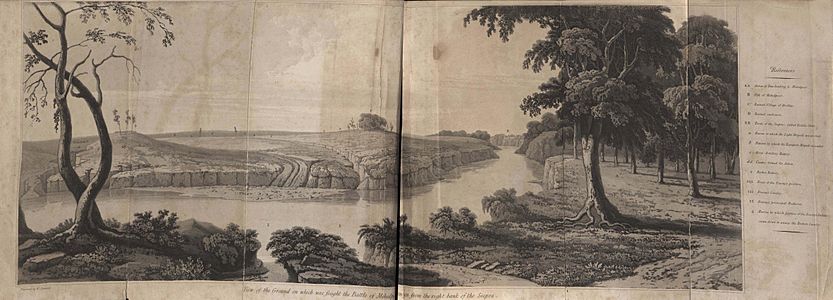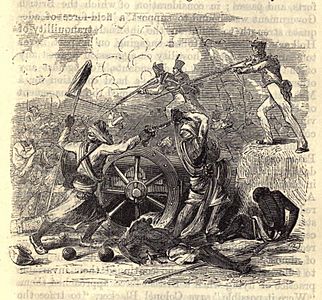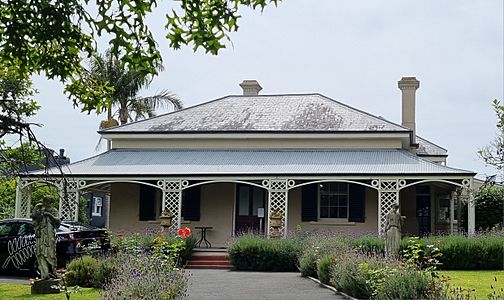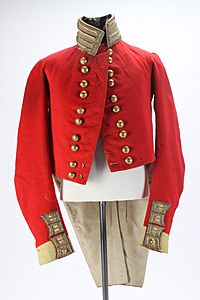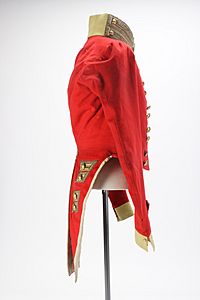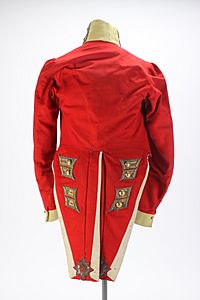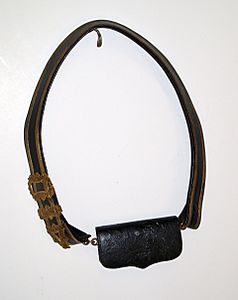William Hulme (British Army officer) facts for kids
Quick facts for kids
William Hulme
|
|
|---|---|
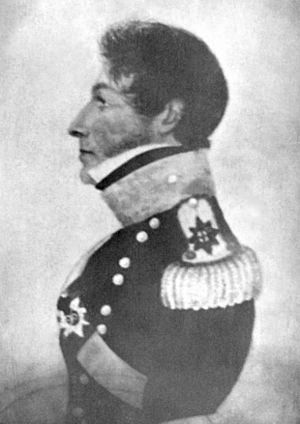
William Hulme, 96th Regiment of Foot
Auckland Libraries |
|
| Born | 10 May 1788 Halifax, Nova Scotia |
| Died | 21 August 1855 (aged 67) Auckland, New Zealand |
| Buried |
Symonds Street Cemetery, Auckland
|
| Allegiance | |
| Branch | |
| Years of service | 1803–1849 |
| Rank | Lieutenant Colonel |
| Unit | Nova Scotia Fencibles, 1803–
1st Regiment (Royal Scots), 1805– 7th Royal Fusiliers, 1822– 96th Regiment, 1824–49 |
| Commands held | New Zealand, 1844–45 |
| Campaigns | Third Anglo-Maratha War
Flagstaff War
|
| Awards | Army of India Medal, Maheidpoor clasp |
| Other work | Member, General Legislative Council of New Zealand, 1849 Justice of the Peace for the Province of New Ulster, 1849– Postmaster, Province of Auckland, 1854–55 Manager, Colonial Bank of Issue, Auckland |
Lieutenant Colonel William Hulme (10 May 1788 – 21 August 1855) was an officer of the 96th Regiment of Foot, British Army.
Contents
Early years
William Browne Hulme was born at Halifax, Nova Scotia on 10 May 1788. He was educated at King's College, Windsor, Halifax, Nova Scotia.
Career
Upon leaving college, Hulme received a commission as ensign in the newly raised Nova Scotia Fencibles on 23 September 1803.
West Indies
The first and second battalions of the 1st (Royal) Regiment of Foot had been stationed in the West Indies since 1803. Hulme joined the regiment with the rank of lieutenant on 26 June 1805, but his service in North America soon came to an end on 17 December 1805. A substantially reduced second battalion returned to England in January 1806 to news of the revolt of two Sepoy battalions employed by the East India Company at Vellore and of other troubles. The battalion was immediately ordered to India, reinforced to 1000 men with volunteers from the third and fourth battalions stationed at Bexhill.
India
Hulme's service in the East Indies began on arrival at the Malay Peninsula on 11 September 1807. The Royal Scots battalion was held over at Prince of Wales Island until November, landed at Madras in December, moved out to Walajabad and Bangalore where they remained until 1808, then moved back to Fort St George, Madras. The battalion took to the field in 1809, then split for the year; the left wing to Hyderabad and the right wing to Machilipatnam, reuniting at Machilipatnam in 1811 in expectation of joining Sir Samuel Auchmuty's expedition against Dutch Java but were diverted to Tiruchirappalli instead, in July.
The regiment was restyled as the 1st Regiment of Foot (Royal Scots) on 11 February 1812. In July, four companies suppressed a mutiny of company troops at Kollam, and returned to Tiruchirappalli. They marched to Bangalore, where in April 1813 Lieutenant Colonel Neill M‘Kellar's right wing joined the force in Maratha country and remained in the field for a year. In April 1814, the left wing of 2nd Battalion marched for Ballari and the right briefly formed part of force in southern Maratha country. The two wings met up in Bellari in May, then moved on to Hyderabad and Achalpur where they were employed against Pindari marauders into 1817.
Pindari freebooting had reached a point where, in about August 1817, under the governorship of Francis Rawdon-Hastings, the largest armies in India to date were assembled to isolate and disband Pindari society wherever it could be found, as well as deal to hostile intentions of a rising Maratha Confederacy—the Grand Army commanded by Rawdon-Hastings and the Army of the Deccan commanded by Lieutenant General Sir Thomas Hislop. The Army of the Deccan was a distinct force consisting of seven divisions, not including irregular infantry or horse of Nizam, Pune or Nagpur, amounting to 54,465 rank & file, of which of the flank companies of the Royal Scots, some 171 rank & file, formed part of the First Division under Hislop.
Third Anglo-Maratha War
Mahidpur
Stationed at Jalna, Captain Hulme's two Royal Scots flank companies, with two regiments of native cavalry and four guns, marched out north-northeast on 11 October 1817, to join 1st division headquarters at Harda on 22 October. Brevet Lieutenant Colonel Thomas Fraser's Royal Scots companies marched out east-northeast on 15 October for Mehkar but were redirected to assist the British force under attack at Nagpur. Joining the 2nd division at Amravati on 7 November, they moved on to take part in the Battle of Sitabuldi, Nagpur. Meanwhile, Hulme and his flank companies, moving northwest, crossed the Narmada River in flat-bottomed boats with the 1st division on 30 November, arrived at Piplya on 8 December and marched on to encamp near Ujjain, some 28 miles (45 km) from Mahidpur. The 1st and 3rd divisions of the army encamped there on 12 December.
On 14 December they marched for Mahidpur where the army of the Marahaja of Indore, Malhar Rao Holkar III, Hari Rao Holkar and Bhima Bai Holkar, had assembled. Brigadier General Sir John Malcolm, as political officer, received Holkar's representatives on 15 December but dismissed them after some four days of unsuccessful negotiations and prepared for attack.
On the morning of 22 December, Holkar's army were found arranged in two lines on the high ground about the ruined hilltop village of Dubli about half a mile beyond the ford on the Shipra River. Daunting in appearance, the first line of infantry numbering some 5,000 stretched across from their left toward the Shipra, near Mahidpur, to a river on their right, and were covered in front by an artillery line of some 76 guns. Beyond that, second line of a dense force of 30,000 horse filled the plain. The British forces numbered under 5,500, of which the 1st Brigade, infantry of the line, under Lieutenant Colonel R. Scott, Madras European Regiment (MER), was made up of Royal Scots flank companies under Captain Hulme, the Madras European Regiment under Major Andrews, 1/14th Madras Native Infantry (1/14th MNI) under Major Smith and 2/14th Madras Native Infantry (2/14th MNI) under Major Ives.
Crossing the river at the ford, they came under cannon fire and formed up under shelter of the opposite bank, along with Hislop staff. Malcolm ordered Hulme's flank companies, the MER and 2/14th MNI to move up and form on top of the bank.
Hulme's flank companies were tasked with leading the attack toward the right on Holkar's left flank and at Dubli. Steady but determined, suffering severe injuries from grape and chain shot, a bayonet charge through Holkar's artillery cleared Dubli and drove the flank's infantry to flee; Holkar's artillerymen carrying on their deadly cannonade to the last. Holkar's left flank were pursued along the river bank to their camp, which when attacked by the Royal Scots caused them to retreat across the river. Holkar's right flank was overpowered at the same time by infantry and cavalry, and the centre, finding both flanks turned, gave way on the appearance of a brigade ascending from the river. Holkar's horse had also fled in the action, Holkar's artillery turning some guns and firing a salvo upon them as they left.
The engagement, which ended at 1:30 pm had lasted some two or three hours. Malcolm, thereafter, pursued Holkar to Mandsaur where a treaty was settled on 6 January 1818, defining the state's territories that were to be defended against all enemies.
In general orders of 23 December 1817, Hislop observed:
The undaunted heroism displayed by the flank companies of the ROYAL SCOTS in storming and carrying, at the point of the bayonet, the enemy's guns on the right of Lieut.-Colonel Scot's brigade was worthy of the high name and reputation of that regiment. Lieutenant M‘Leod fell gloriously in the charge, and the conduct of Captain Hulme, Captain M‘Gregor, and of every officer and man belonging to it entitles them to his Excellency's most favourable report and warmest commendation.
With Sir John Malcolm's support, Hulme was awarded the rank of Brevet Major on 23 December 1817. Battle honours of Nagpore and Maheidpoor were added to the 1st Regiment (Royal Scots) colours on 26 February 1823. The loot seized during this campaign was enormous, and led to bitter argument over prize money for many years. Following approval of the Army of India Medal (AIM) in 1851, Hulme, then retired in New Zealand, was amongst thirty-eight recipients with the Maheidpoor clasp, presented to officers and men of 1st Regiment (Royal Scots), 2nd Battalion, who were specially mentioned in the Commander-in-Chief's orders.
New Zealand
Relieving Major Thomas Bunbury and the 80th Regiment in New Zealand, Brevet Lieutenant Colonel Hulme arrived in Auckland on 14 April 1844, from Launceston, Van Dieman's Land, on the Marion Watson, along with Lieutenant Edward Barclay, Assistant Surgeon Stewart, and 59 soldiers of the 96th Regiment. Major Robertson, Ensign John Campbell and 55 soldiers and family's had arrived by the Water Lilly on the same day.
His military career is perhaps better known for his part in the Flagstaff War, 1845–1846, the first Anglo-Māori war.
Flagstaff War
Otuihu
Governor Robert FitzRoy gazetted a proclamation of martial law within 60 miles of Russell as well as notice of 26 April, stating that: "During the continuance of war, no natives may approach the Ships, the Soldiers, or encampment at the Bay of Islands,—wherever placed; without having a Missionary, or a Protector, with a white Flag, with them, lest the Soldiers should mistake friends for enemies, and fire upon them in error."
HMS North Star had sailed for the Bay of Islands on 23 April. The barque Slains Castle with the 58th Regiment under Major Cyrprian Bridge, brigantine Velocity and schooner Aurora with the 96th Regiment under Lieut. Colonel Hulme and about 50 volunteers under command of Cornthwaite Hector, sailed out of Auckland for the Bay of Islands on 27 April, anchoring off Kororāreka on the 28 April. After consultation with Sir James Everard Home, HMS North Star at anchor, about re-establishing authority there, the Grenadier company of the 58th Regiment were landed, a proclamation was read, the Union Jack was hoisted under a 21 gun salute from HMS North Star, the yards were manned and three cheers from the troops on shore were answers by the sailors and troops on board the ships.
Hulme later reported to FitzRoy that in obedience with FitRoy's instructions, he "prepared to attack the rebel chiefs, and to destroy their property". On the morning of 29 April. HMS North Star, Velocity, Slains Castle and Aurora moved off for Waikare Inlet but light winds slowed their five mile voyage to a midnight anchorage off Otuihu, the exposed pā of a supposed rebel chief, Pomare. Hulme reported:
At daylight, I was much surprised to see a white flag flying in Pomare's pah; but as the proclamation only authorized loyal natives to shew it, I could not recognise it as an emblem of peace from a supposed rebel.—The troops commenced disembarking, and when landed, I sent two Interpreters with a message into the pah, to desire Pomare to come to me directly; his answer was,—"The Colonel must come to me." He sent the same answer to a second message. One of the interpreters now offered to remain a hostage in the pah—this I would not hear of. I then sent my final message to Pomare, that if he did not come to me in five minutes, I would attack his pah, this threat induced Pomare to come.
Hulme's two interpreters were Joseph Merrett and Edward Meurant. Merrett explained to the Auckland Times in May:
Both Mr. Meurant and myself used every argument to persuade him to trust to the word of our commanding officer—that no one would hurt him. I had never been told officially that Pomare was to be taken a prisoner, and must go, as such, to the Governor, on board the "North Star,"—nor did I for a moment believe that Colonel Hulme, in the presence of his officers, would promise the chief safety, and, in the face of that promise, make him a prisoner of war. I had told Pomare that the word of my officer was the word of a gentleman, and that it would not be broken. While Mr M. and myself were in the midst of the natives, the troops were seen advancing up to the pah (who ever heard of an armed body walking, under a flag of truce, into an enemy's encampment with the intention of destroying it—a flag of truce at the same time flying the forces of the latter—and making a hostile advance while their own interpreters were offering proposals from one party to the other)
My instructions were to bring the chief to the Colonel, and he had agreed to accompany me, but this movement of the troops, in a moment gave the signal of action on the part of the natives. A moment more and a destructive fire would have been opened, and our men must, have suffered severe loss, I ran past the natives, and told the Officer in command, of all the circumstances, the advance was then stopped. Pomare went down with Mr. Meurant and myself, leaving the soldiers and natives within pistol shot of each other, each waiting for the signal to commence the combat. When Pomare reached the troops some conversation took place between the Colonel and him, through the interpreters…
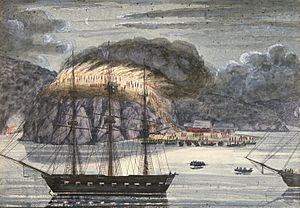
Alexander Turnbull Library
Hulme explained to Pomare that his conduct had been very bad; that he must go on board North Star, and accompany Hulme to Auckland to account for it to the Governor. Merrett continued:
...and to my great surprise, in a few minutes a file of soldiers wore ordered to surround Pomare and make him prisoner. I accompanied him on board the North Star at his request, he seemed very much dispirited, and surprised at the sentinels being placed over him; and the tears came in his eyes while speaking of his wife and children, he said he had trusted to the faith of Europeans whom he had always protected; but that he had been taken treacherously. I told him he could not blame me, and repeated literally the instructions I had received from Colonel Hulme; he said he would not blame me, and gave me his ammunition box as a proof of his confidence in what I had said,—he much wished me to stay with him on board, and go with him to the Governor; he wrote a letter to his people telling them to retire to their homes peaceably, as he was a prisoner and security for their good behaviour; he wished to have his wife and children on board. In the evening his pah was plundered and burnt, and an attempt was made by the commanding Officer to cut off the retreat of his people, and disarm them; but it was delayed too long, and the natives escaped.
Thomas Bernard Collinson, RE, commented in 1853, that: "It was unnecessary to destroy his pah; but there is no doubt Colonel Hulme was actuated by feelings of humanity. The character for gallantry he obtained, even during this short campaign, is a sufficient proof of that."
Puketutu

State Library of New South Wales
Hulme also commanded the military forces during the attack on Heke's pā at Puketutu (sometimes called Te Mawhe Pā) on the shores of Lake Ōmāpere. In May 1845 Heke's pā was attacked by troops from the 58th, 96th and 99th Regiments with marines and a Congreve rocket unit.
The colonial forces arrived at Heke's pā at Puketutu on 7 May 1845. Lieutenant Colonel Hulme and his second in command Major Cyprian Bridge made an inspection of Heke's pā and found it to be quite formidable. Lacking any better plan they decided on a frontal assault the following day. Te Ruki Kawiti and his warriors attacked the colonial forces as they approached the pā, with Heke and his warriors firing from behind the defences of the pā. There followed a savage and confused battle. Eventually the discipline and cohesiveness of the British troops began to prevail and the Māori were driven back inside the pā. But they were by no means beaten, far from it, as without artillery the British had no way to overcome the defences of the pā. Hulme decided to disengage and retreat back to the Bay of Islands. Hulme returned to Auckland, and from the arrival of additional troops in June 1845, was superseded in command of the forces in New Zealand by Lieutenant Colonel Henry Despard, 99th Regiment, a soldier who did very little to inspire any confidence in his troops.
Later life
In 1846 he purchased a house in Parnell, Auckland, which became and is still known as Hulme Court. While not open to the public, this is on the New Zealand Historic Places register and is one of the oldest documented houses in Auckland still standing.
Tasmania
Based in Hobart, Van Diemen's Land, with his troops, since arrival of the ship Java on 19 December 1846, Hulme advanced from Brevet Lieutenant Colonel to Lieutenant Colonel without purchase in 1848. He then retired from soldiering in 1849 and moved back to New Zealand.
New Zealand
Legislative Council
In July 1849, Governor George Grey, appointed Hulme to member of the General Legislative Council. That year, Hulme introduced the idea of a motion and ordinance in favour of enabling Maori land in the northern district of New Zealand to be used for cattle grazing by squatting. "Nothing, he thought, would tend so much to the general good and welfare of New Zealand as the opening up of its lands to the occupation of European settlers and squatters." In response: "The Governor said that the resolution as it now stood could not be entertained by the Council—but he thought that they might readily adopt a different one, which might answer the ends aimed at, and be less objectionable. As it stood he could not advise its adoption, for this reason that it involved a question that was one of universal interest for the whole of New Zealand, South as well as North; and although the General Legislative Council of the whole islands had power vested in it to adopt resolutions on this subject, yet as this Council did not represent the whole islands, it could not entertain a subject affecting the entire country."
Post Office
Hulme was appointed by Governor George Grey as the first Postmaster for the Province of Auckland from 1 January 1854 but received less support in the idea of an appointment to Postmaster-General for New Zealand.
Death
William Hulme died on Tuesday, 21 August 1855, in his 68th year and was buried with military honours in Symonds Street Cemetery on Friday, 24 August. The New-Zealander wrote:
The late Lieut. Col. Hulme was a fine specimen of a thorough English soldier; intrepid and cool on all occasions.
In 1849 he sold out of the service, and returned to Auckland, where to the hour of his death, he was all along held in the highest estimation as an upright and honourable colonist.
-
Hulme Court, Parnell, Auckland, 2022.
-
96th Regt full dress coatee worn by Lt Col William Hulme.
Auckland Museum -
Cross belt and pouch worn by Lt Col William Hulme.
Auckland Museum -
A pair of Gill and Knubley flintlock duelling pistols, circa 1790, possibly owned by Lt Col William Hulme.
Auckland Museum


